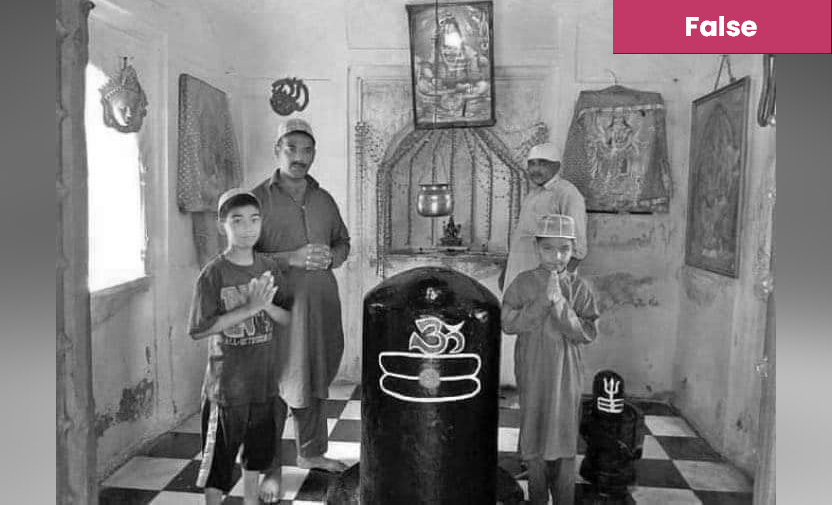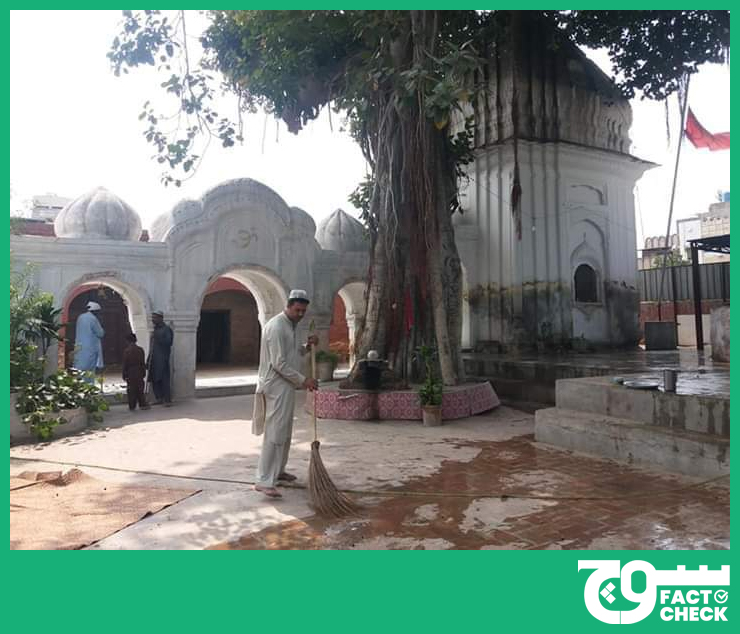
Claim: Hindus in Pakistan’s Khyber Pakhtunkhwa (KP) province are forced to wear topis — caps typically worn by Muslim men during prayers — when they enter the Guru Gorakhnath temple near Peshawar, the only remaining Shiva temple in the country.
Fact: There is no truth to the claim. The Hindu community is free to worship in the Guru Gorakhnath temple in Peshawar’s Gorkhatri area without any compulsion to wear a topi. Furthermore, the Gorakhnath temple is not the only remaining Shiva temple in Pakistan.
On 27 June 2022, Facebook page ‘The Saffron Chariot’ shared a picture of four men, including two children, standing in a Shiva temple with their hands clasped and all of them wearing a topi — a net cap typically worn by Muslim men while praying.
The post was accompanied by the following caption in Hindi and English:
“Hindu minorities worship at the only remaining Shiv temple in Khyber Pakhtunkhwa near Peshawar, Pakistan.
Their compulsion is that- they have to worship in the temple by wearing a netted cap. One thing is special in this picture of Pakistan…..The Hindus there are based on Hindutva..!! This picture is a lesson to the secular Hindus of India…!!”
Fact or Fiction?
Soch Fact Check used Google Reverse Image Search and Google Lens to investigate the image and found a 2019 news article by the Express Tribune, archived here, which discusses the Hindu community in Peshawar, KP.
“Zahid Kumar and his two sons take to the historic Goro Goraknath temple in the middle of Peshawar, to spend their day in service,” reads a sentence in the first paragraph of the article. The man pictured on the left is Kumar, with his two sons in front of him. The man on the right side of the photo at the back is Ravi Kumar, according to Wisal Yousafzai, the Express Tribune reporter who filed the story.
Yousafzai told Soch Fact Check that wearing a cap “is a tradition as well as respect” in Peshawar. “In every religious place like temple, mosque, and gurdwara, people either wear a cap or cover their head with a handkerchief to give respect,” he said. He also explained that the Guru Gorakhnath temple is not the only one in Khyber Pakhtunkhwa.
Yousafzai also sent us a picture of himself on a visit to the same temple where he can be seen wearing a cap to “give respect to the religious place”.

Soch Fact Check also reached out to Pandit Gopal Varma, a Hindu teacher and cleric based in Peshawar. Varma termed the claim a rumour and said there has been no decree or notification forcing members of the minority community to wear net caps in temples.
He also explained that there are at least three major temples in Peshawar, including the Kalibari Mandir and the Dargah Pir Ratan Nath Jee temple. Though he did not know the exact number of temples, including Shiva temples, in Pakistan, he said there are many in Sindh. There are temples in KP’s Kohat, Dera Ismail Khan, and Hangu, as well as the famed Mansehra Shiv Temple, which has a Shivling about 4-4.5 feet high and 6-7 feet wide.
In Kallar Kahar, Punjab, there are the Katas Raj Temples, while the Shri Laxmi Narayan Mandir and Shri Swaminarayan Mandir are located in Karachi — a list of temples in Karachi can be found here and a list of temples in Pakistan here, here, and here.
In the Hindu tradition, the Shivling — also known as linga, lingam, and Shiva linga — is a symbolic or devotional representation of the Hindu god Shiva. A thick black cylindrical shape, it is marked with a few, often interconnected, white lines and the Om sign. The same is also visible in the picture accompanying the viral claim.
Kumar has posted pictures of the Peshawar temple as well, which can be seen here and here. Other posts related to the temple are visible here and here.
Virality
Soch Fact Check conducted a CrowdTangle analysis for the period from 1 June 2021 to 13 July 2022 using the following search terms:
- “Hindu minorities worship at the only remaining Shiv temple in Khyber Pakhtunkhwa near Peshawar”
- “Hindu only Shiv temple Peshawar”
- “पाकिस्तान के पेशावर के पास खैबर पख्तूनख्वा में एकमात्र बचे शिवमन्दिर में पूजा करते हिन्दू अल्पसंख्यक [Hindu minorities worship at the only surviving Shiva temple in Khyber Pakhtunkhwa near Peshawar, Pakistan]”
- “इन्हें मंदिर में पूजा भी जालीदार टोपी पहनकर ही करनी पड़ती है। पाकिस्तान के इस तस्वीर में एक बात खास है [They also have to worship in the temple wearing a netted cap]”
- “ಹಿಂದೂ ಪೇಶಾವರ್ ಟೋಪಿ [Hindu Peshawar Hat]”
- “Hindoe-minderheden bidden in de enige overgebleven Shiva-tempel in Khyber Pakhtunkhwa bij Peshawar [Hindu minorities pray at the only remaining Shiva temple in Khyber Pakhtunkhwa near Peshawar]”
The first and second search terms turned up six Facebook posts with 1,760 interactions and 15 Facebook posts with 2,454 interactions, respectively.
The third and fourth search terms, both of which are in Hindi, garnered 98,872 interactions across 248 posts on Facebook and 86,502 interactions across 219 posts, respectively. The fifth term, which is in Kannada or the Canarese language, showed more than 3,500 interactions across almost 10 posts. The sixth turned up seven Facebook posts.
The second and third search terms first peaked in July and June 2021 and this Facebook post is performing 26.5 times better than its counterparts. Through our CrowdTangle analysis, we determined that a post by Sanatan Nation received the highest number of reactions and comments (over 11,200 and 400, respectively), while a post by Manoj Pareek in a Facebook group was shared more than 1,400 times.
This is not the first time the claim has surfaced on social media. In June 2021, Facebook page ‘Hinduism The Eternal Truth.’ posted the same image and claim and the post again emerged in March 2022. The post on page ‘Saffron Chariot’ was shared close to 150 times and received over 1,100 reactions, whereas the one on ‘Kaliyuga Darshan’ got almost 100 shares.
The false claim was also shared on Instagram pages @kattar_hindu_saamrajya_ and @lucifermeme_.
Conclusion: Claims that members of the Hindu community in KP are required to wear topis to worship in the Guru Gorakhnath temple in Peshawar’s Gorkhatri area are false. Further, the Gorakhnath temple is not the only or last remaining Shiva temple in Pakistan.
